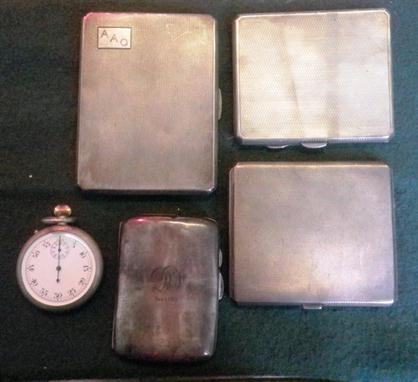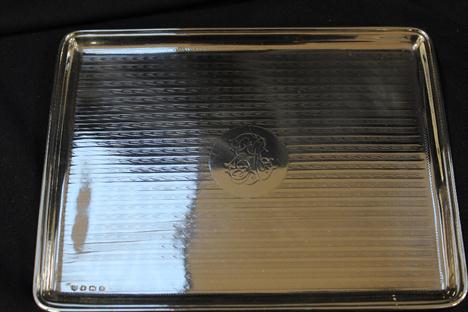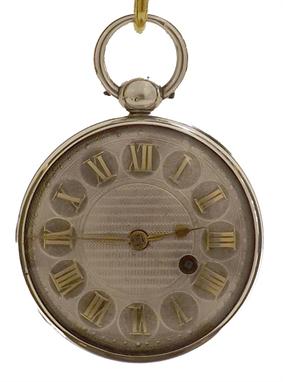186062 Preisdatenbank Los(e) gefunden, die Ihrer Suche entsprechen
186062 Lose gefunden, die zu Ihrer Suche passen. Abonnieren Sie die Preisdatenbank, um sofortigen Zugriff auf alle Dienstleistungen der Preisdatenbank zu haben.
Preisdatenbank abonnieren- Liste
- Galerie
-
186062 Los(e)/Seite
A rare Lancashire wheel cutting engine. Inscribed for the original owner David Davies, London and dated 1776 The cutter frame with pivoted vertical movement against an adjustable screw-stop mounted onto the substantial box frame via a screw-adjusted horizontal slide, the 15.25 inch brass circular index plate with forty two division rings ranging from 6 to 365 and engraved David Davies, LONDON with repeat name and dated MAY THE 29 1776 to inner margin, located via a sprung detent fixed to the front of the frame and with central arbor passing through the frame to hold the work, the whole on four down-curved spiked supports, length of frame 74cm (29ins); with a selection of accessories including cutter arbors and a copy of Crom, Theodore R. HOROLOGICAL WHEEL CUTTING ENGINES 1700-1900 published by the author, Gainesville Florida, second edition 1976, (2). The overall design, construction and layout of the current lot can be directly compared to an engraving of an English wheel cutting engine published in Enderson, William The Principles of Mechanics, second edition 1758 (see Crom, Theodore R. Horological Shop Tools 1700-1900 page 634). An almost identical engine (signed for Daniel Fenn, London) is illustrated in Crom, Theodore R. HOROLOGICAL WHEEL CUTTING ENGINES 1700-1900 page 93; another from the workshop of the late John Hooper was sold in these rooms Tuesday 10th February 2009 lot 47. David Davies is recorded in Loomes, Brian Watchmakers & Clockmakers of the World, Volume 2 as working in London during the second half of the 18th century; as such engines are thought to have been made in Lancashire it is most probable that he was the original owner rather than the maker.
An English silver cased verge fusee pocket watch Henry Hindley, York circa 1760 the case later The gilt full-plate movement with square baluster pillars, silvered regulation dial, finely engraved and pierced foliate engraved backcock with diamond endstone and signed H. Hindley, York, 842 to the frosted gilt backplate, the dust cover with conforming signature, the circular white enamel Roman numeral dial with gilt spade hands now in a plain case with post and suspension loop at 12 oÕclock, case marked for London 1827 makerÕs mark HJ, (case with wear, outer case lacking), diameter 4.4cm. Henry Hindley was born in Great Harwood, near Blackburn, Lancashire 1699. Little is known about his early life, however by the mid 1720Õs he was making clocks in Wigan where he repaired the church clock in 1720. Hindley moved with his young family (including his son, Joseph born 1728) to the city of York where, after making clocks for the Mansion House and Guildhall, he gained his Freedom of the city in 1732. HindleyÕs talents were such that he equipped his workshop with tools of his own design including an important dividing and wheel cutting engine, a screw cutting lathe and a fusee engine. As well as for domestic clocks Hindley received commissions for many turret clocks including York Minster and supplied a range of scientific instruments including two important equatorial telescopes for the Duke of Norfolk and William Constable. By the 1760Õs HindleyÕs health had deteriorated to the extent that an increasing proportion of the business was handled by his son, Joseph. Henry died in 1771 with his son and successor Joseph unfortunately dying just three years later in 1774.
A Swiss silver mounted mother of pearl cased miniature carriage timepiece Unsigned, circa 1900 The frosted gilt keyless watch movement with cylinder escapement and circular mid blue engine-turned enamel dial applied with white Arabic cartouche numerals and with blued steel spade hands, set behind a convex glass, the case with hinged handle and winding crown to the projecting top panel, on conforming base with turned feet, the underside engraved with Swiss cross motif and inscribed BREVET 33817, 5cm (2ins) high excluding handle; with original blue silk lined green morocco travelling case with retailers stamp for A. Barrett & Sons, 63 & 64 PICCADILLY, LONDON to underside, the case 7.5cm (3ins) high.
A fine French Louis Philippe rosewood and marquetry mantel clock with calendar and alarm Taveau Freres, Paris, mid 19th century The eight-day countwheel bell striking movement with fine beat adjustment to pendulum crutch and take-off for the calendar work set beneath, the circular white enamel Roman numeral dial signed Taveau Freres to centre, with fine gilt ÔarrowÕ hands and blued steel alarm setting hand within a gilt brass engine-turned convex glazed bezel, the rectangular plinth-form case with figural surmount cast as cupid kneeling whilst holding pan pipes above fascia with fine brass, mother of pearl and ivory butterfly inhabited marquetry decorated panel infill around dial, over rectangular glazed aperture enclosing silvered subsidiary day-of-the-week and date-of-the-month dials, the sides divided into panels with brass double line borders, on cavetto moulded skirt base fronted with a scallop-shell centred foliate scroll inlaid panel, with rounded angles and on shallow squab feet, 48cm (19ins) high; with a later well made rosewood wall bracket with rectangular platform with single curved support, 19cm (17.5ins) high, the clock and wall bracket 67cm (22.5ins) high overall.
A French Second Empire small ormolu mantel clock Unsigned, mid 19th century The eight-day countwheel bell striking movement with gilt engine-turned centre within white enamel Roman numeral chapter ring and floral trail cast bezel to dial, the rectangular case with cavetto cornice above winged baton and laurel cast upper quadrant mounts the apron applied with flaming torches and festoon swag, on shallow leaf cast skirt base with disc feet, 22cm (8.75ins) high.
A William IV ormolu small mantel timepiece James Murray, London, circa 1835. The circular four-pillar single chain fusee movement with off-set pallets and signed James Murray, LONDON to backplate, the 3.35 inch circular gilt engine-turned Roman numeral dial with heart pierced blued steel hands and decorative milled bevel-glazed bezel, the waisted finely chased rococo-scroll cast case with cartouche crest and conforming panel beneath dial, the sides cast with repeating leafy bands, on cabriole supports, 21cm (8.25ins) high. James Murray was born in 1780, he gained his Freedom of the ClockmakersÕ Company in 1815, was elevated to the Livery in 1817 and is thought to have worked until his death in 1847. He is perhaps best known as a maker of marine chronometers and other precision timekeepers; James Weddell took three chronometers supplied by Murray on his third Antarctic expedition 1822-4.
Rare gilt metal two time zone lever pocket watch, signed James Courvoisier, Locle, no. 44792, gilt frosted two train movement jewelled to the centre, the cream dial with two subsidiary time zone dials over constant seconds, outer Arabic chapter with sweep centre seconds, engine turned case with ribbed band, 54mm
18ct fusee cylinder pocket watch, hallmarked London 1827, signed Alexr Cumming, London, no. 1207, pierced balance cock with diamond endstone under a gilt dust cover, enamel dial with Roman numerals, spade hands, engine turned consular case with a small engraved family crest to the centre, 126.5gm, 50mm
Silver fusee pocket watch with Savage two-pin escapement, hallmarked Chester 1826, signed Abm Jackson, Castle Street, Liverpool, no. 9213, with Liverpool windows, three arm mono-metallic balance with diamond endstone, the dial with Roman numerals and subsidiary seconds, arrow hands in a plain case with applied gold hinges, engine turned band and cuvette, 50mm
Interesting Waltham gold filled custom made Tourbillon pocket watch, no. 7869070, frosted gilt three-quarter plate movement with going barrel, bi-metallic balance with lever escapement revolving approximately once a minute, engraved `Custom Order 1901`, enamel dial with Arabic numerals, subsidiary seconds, outer Arabic five minute division, engraved and engine turned case, 54mm. This watch was made by Mr George Thomas of Luthersville, MD, USA. It was a prototype for a series of only six `specials` that he handmade in the 1970s
18ct hunter pocket watch with resilient patent lever escapement, London 1872, gilt three-quarter plate fusee movement signed Thomas Roberts, Liverpool, no. 53437, compensated bi-metallic balance with ruby endstone, enamel dial with `Up and Down` dial over subsidiary constant seconds, Roman numerals and blue steel spade hands, engine turned case with engraved monogram, 109.5gm, 51mm . The resilient lever escapement was one of James Ferguson Cole`s inventions with the unusual banking system, the purpose of which was to reduce shock to the mechanism
Interesting Ernest Jeunet white metal hunter pocket watch with Pirouette escapement, signed Ernest Jeunet, Meadville, PA, circa 1860, frosted gilt three-quarter plate movement jewelled to the centre, hanging barrel, three arm balance, brass pirouette wheel with blued steel hairspring actuating the steel lever, 24 point tooth steel escape wheel, the dial with Roman numerals and centre seconds with Halberd hands, the cuvette inscribed `Rail-way Time-keeper`, engine turned case with engraved cartouche, 54mm (a.f)
Regency silver fusee verge pocket watch, London 1823, the movement signed Thos Allison, Wakefield, no. 6298, plain cock with flat steel balance and diamond endstone, elaborate silver engine turned dial with applied Roman numerals and winding hole at the four o`clock position, consular case, 45mm
-
186062 Los(e)/Seite



























































